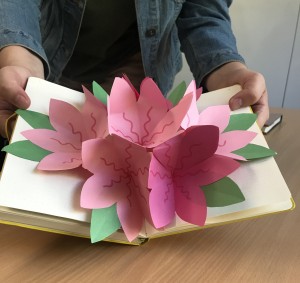 Five students crowd around a table and take out their journals and origami works-in-progress, some simple and some more elaborate. This is Mathematics and Art, a new half course taught by math faculty member Anne Kaufman.
Five students crowd around a table and take out their journals and origami works-in-progress, some simple and some more elaborate. This is Mathematics and Art, a new half course taught by math faculty member Anne Kaufman.
In this first unit of the semester, Ms. Kaufman is using Dr. Robert Lang’s website and TED talk on math and the magic of origami as a jumping-off point. “Figuring out the folding process allows students to do things they couldn’t imagine doing before. And seeing the bones of shapes has been an interesting exercise,” she says.
Students use Dr. Lang’s TreeMaker software as they progress to more sophisticated shapes. Today, each student chooses an animal from images of “taxidermy origami,” 3D images of animal heads folded out of one piece of paper. First, they must sketch out a stick figure of the base before figuring out the crease patterns.
Ms. Kaufman says after the origami unit, they will move onto perspective, particularly looking at the “bones” of painting. Throughout the year, students will work in a range of media from digital design and 3D printing to fiber arts. Faculty members from other departments will also contribute in areas such as engineering.
When class is over, there is a collective groan from students because they enjoy this work. One student has questions about the difficulty of taxidermy origami. “What does the phrase productive struggle mean to you?” Ms. Kaufman asks the whole class. “There’s value in the struggle. The process of trying to figure it out is useful in seeing how folding and math come together. Continue to experiment, and if it doesn’t work, it doesn’t work. We will talk about why next time.”